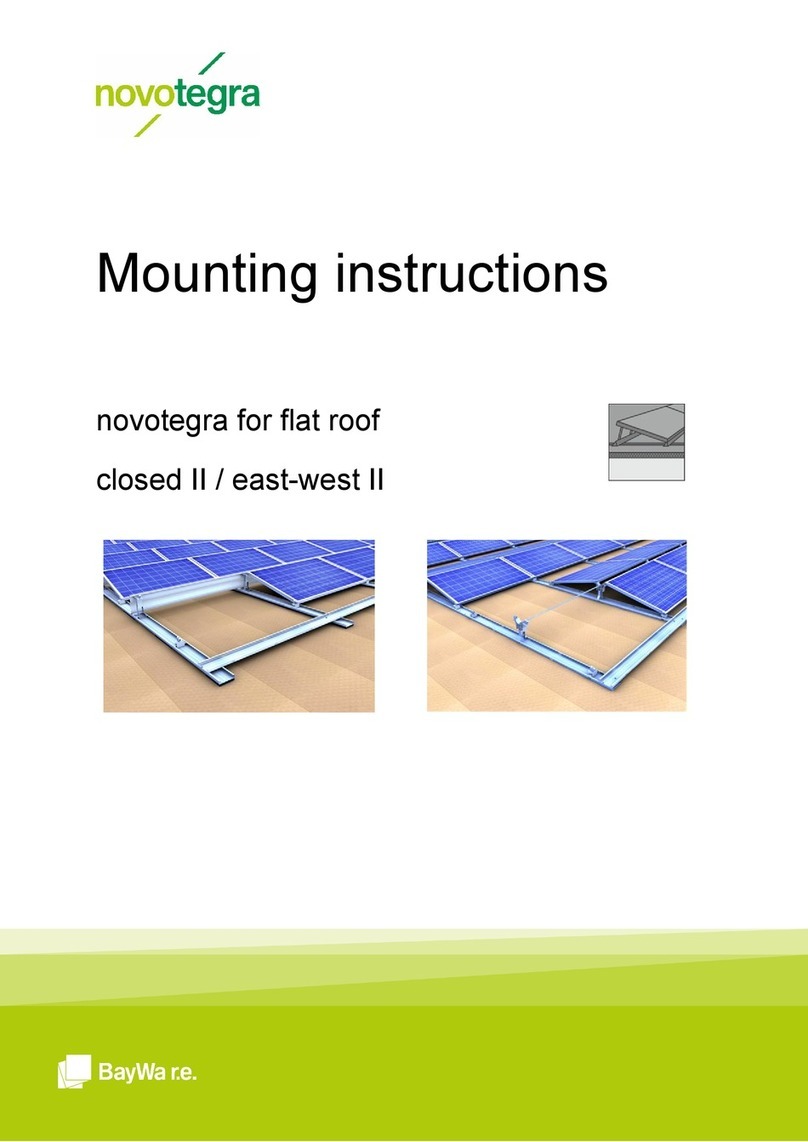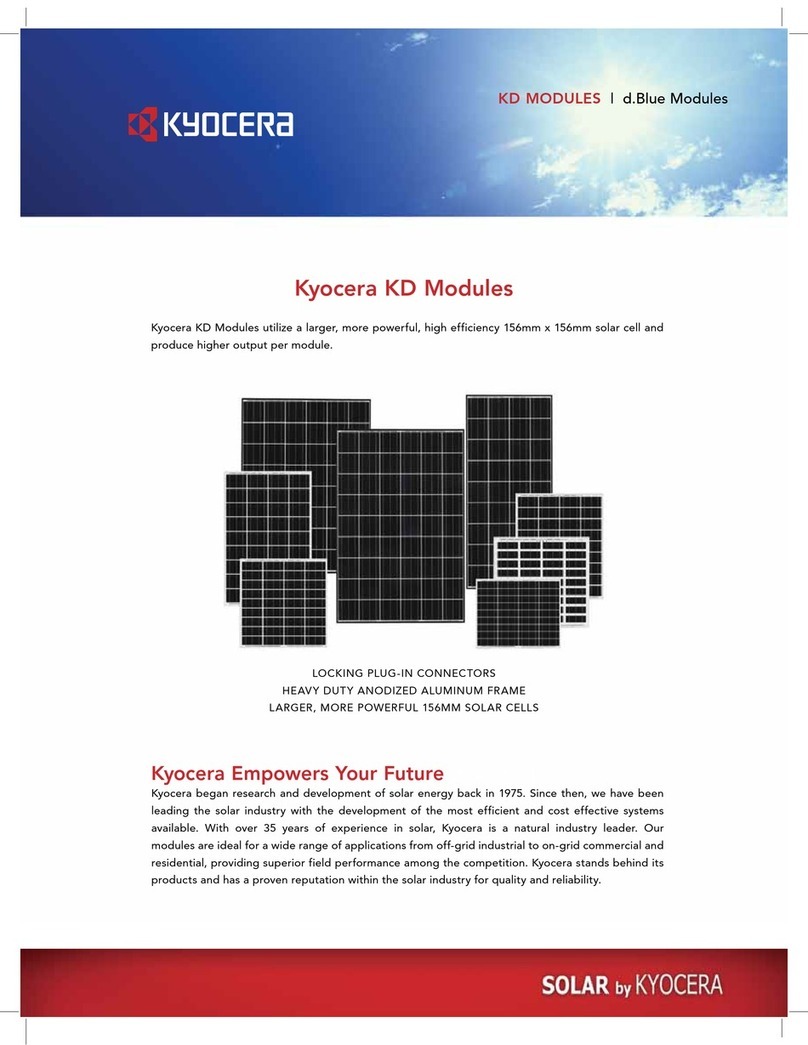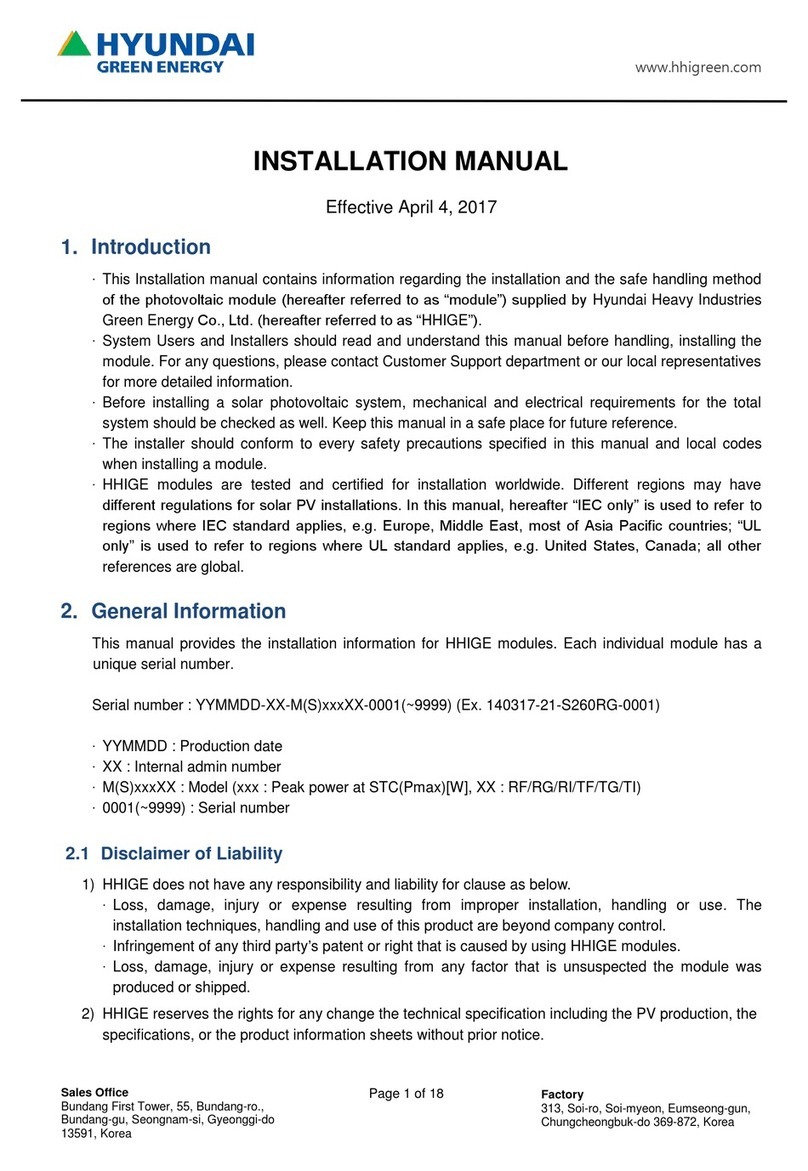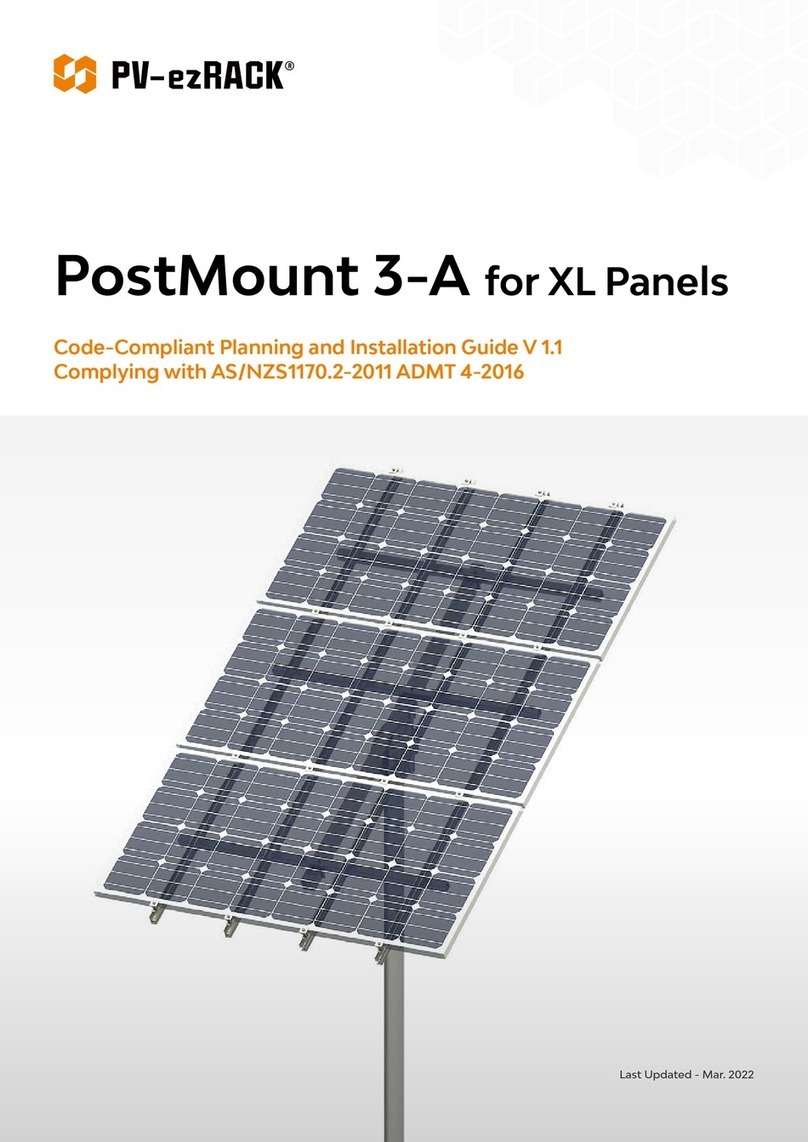BayWa closed II User manual

I
Installation manual
novotegra for flat roofs
closed II / East-West II

II
CONTENTS
1 INFORMATION ............................................................................................................... 1
2 INSTALLATION SYSTEM MAINTENANCE .................................................................... 3
3 NOVOTEGRA FOR FLAT ROOFS II .............................................................................. 3
4 SYSTEM COMPONENTS, TOOLS AND WORK EQUIPMENT....................................... 4
4.1 Re uired for installation ............................................................................................. 4
4.2 Installation system components – installation variants ............................................... 5
4.3 Installation system components – optional ................................................................. 6
5 INSTALLING THE SUBSTRUCTURE .............................................................................
5.1 Installing the base rails and support components ....................................................... 7
5.2 Module installation, load redistribution and ballast ..................................................... 8
5.3 Installation variants ...................................................................................................10
6 WARRANTY / PRODUCT LIABILITY AND DISCLAIMER .............................................13

1
1 INFORMATION
Safety information
Installation work may only be carried out by ualified expert personnel. Safety clothing in accordance with
the relevant national regulations and guidelines must be worn during all work.
Installation must be carried out by at least two people so as to ensure that help is available in the event of
an accident.
All relevant nationally and locally valid occupational safety regulations, accident prevention regulations,
standards, construction regulations and environmental protection regulations must be observed, along with
all regulations of the institutions for statutory accident insurance and prevention.
National regulations for working at height or on roofs must be complied with.
Electrical work must be carried out in compliance with nationally and locally valid regulations and guidelines
and in accordance with the safety regulations for electrical work.
The earthing / potential e ualization of the installation system must be carried out in line with the nationally
and locally valid standards and guidelines.
Classification into hazard classes
In order to draw the user's attention to potentially hazardous situations, the following hazard classes are
used, based on ANSI Z 535. The hazard class describes the risk in the event that the safety information is
not observed.
Warning symbol with signal word Hazard class as per ANSI Z 535
DANGER!
indicates an immediate hazard. Failure to prevent
this could result in death or severe injury.
WARNING!
indicates a potential hazard. Failure to prevent
this could result in death or severe injury.
CAUTION!
indicates a potential hazard. Failure to prevent
this could result in slight or minor injury.
NOTICE!
indicates a potentially damaging situation. Failure
to prevent this could result in damage to the system or
something in its environment.
General information
The product must be checked for completeness upon receipt using the accompanying delivery notice.
BayWa r.e. Solar Energy Systems GmbH shall assume no costs or guarantees for any subse uent
deliveries
by express delivery if missing material is only noticed during installation.
The installation system is suitable for securing PV modules with standard market dimensions.
The maximum permitted module width is 1.10 m.
The suitability of the installation system for the respective project must be checked on an individual basis
with respect to the existing roof sealing / roof construction.
The roof sealing / roof construction must meet the re uirements of the installation system in terms of load-
bearing capacity, load-bearing structure and condition.
The user must test the load-bearing capacity of the existing roof / roof construction (concrete ceiling,
purlins, trapezoidal panels, etc.) or have this tested.

2
The user must take into account structural issues with regard to insulation penetrations (e.g. condensation).
Installation instructions
The components of the novotegra installation system are intended solely for securing PV modules.
Depending on the roof type of the building, installation system components that are suitable for this roof
type must be used.
Strict compliance with the safety and installation instructions in this manual is re uired for compliance with
the intended use of the installation system.
All claims for warranty, guarantee and liability against the manufacturer are rendered null and void in
the event of non-intended use and non-compliance with the safety and installation instructions, non-use of
associated installation components or use of third-party components not belonging to the installation
system. The user shall bear liability for damages and resulting conse uential damages to other
components such as PV modules or to the building itself, as well as for injury to persons.
The constructor must read the installation manual prior to installation. Any open uestions must be
resolved with the manufacturer prior to installation.
Please ensure that a copy of the installation manual is kept in the immediate area of the works on the
construction site.
The assembly instructions (module loading, fastening, clamping ranges, etc.) of the module manufacturer
must be observed and complied with.
Prior to installation, structural analysis for the installation system must be carried out with the loads
foreseen for the project in accordance with national standards. Information relevant to the installation
(e.g. distance between base rails, re uired ballast) is determined by the structural analysis carried out by
BayWa r.e. Solar Energy Systems GmbH.
The permitted roof incline for use of the installation system in accordance with this installation manual is
0 to 5 degrees.
The given tor ue values must be observed and tested on a random basis on site.
Information on structural analysis
The installation system must always be calculated for each project individually by BayWa r.e. Solar Energy
Systems GmbH.
The structural analysis determines only the load-bearing capacity of the novotegra installation system.
The load transfer within the building is not taken into account (structural analysis of existing building).
The load-bearing capacity of the installation system components is determined here based on the planned
module arrangement and the relevant roof data (project data collection). On-site deviations from the
planning may lead to different results.
The load assumptions (load and roof partitioning) are made on a country-specific basis according to the
specifications of the load standards in the Eurocode. In Switzerland, the loads to be applied are determined
according to SIA 261.
In order to comply with the conditions of the wind tunnel tests, the modules must be installed at a distance
of at least 50 cm from the edge of the roof on flat roofs without parapets and at least 50 cm from the inside
edge of the parapet on flat roofs with parapets.
If the building is at an exposed location (e.g. exposed to wind load on a slope) or in the event of snow
accumulation (e.g. roof structures), the user must take responsibility for observing the specifications in the
load standards of the Eurocode or SIA 261 (Switzerland). The design software does not take these cases
into account.
The structural analysis of the installation system is based on the modules being symmetrically mounted on
the support components in order to evenly distribute the load onto the substructure.
The results calculated with the design software such as the distances between the base rails, the uantity
of fastening e uipment (e.g. rail joints), as well as the further calculation information must be observed and
complied with.

3
novotegra is tested and certified by TÜV Rheinland:
2 INSTALLATION SYSTEM MAINTENANCE
The installation system must be checked annually for stability and proper functioning.
In addition to visually inspecting the components and the roof sealing for damage, all screw and click
connections must also be checked.
Components can be removed by following the work steps detailed below in the reverse order.
Maintenance work must be carried out by a specialist company with verifiable experience of electrical
systems and working with installation systems.
3 NOVOTEGRA FOR FLAT ROOFS II
The contents of this installation manual describe the installation of the substructure on roofs with sheet or
bitumen waterproofing.
Depending on the roof seal material, separation and/or protection membranes may need to be added
between the roof seal and the substructure. This must be agreed upon directly between the company
installing the PV system, the building owner and the specialist roof sealing company.
The substructure is installed without penetrating the roof. The PV system is secured against wind suction
by providing ballast (e.g. suitable stones), based on the results of the wind tunnel tests for the system. The
re uired ballast is determined by BayWa r.e. Solar Energy Systems GmbH based on the project data
provided by the installation company. The ballast applies to the planned system; on-site deviations from
planning may lead to different results.
Protection against system sliding is verified based on a coefficient of friction of µ = 0.5. This value must be
checked by the installation company prior to installation. If the coefficient of friction is determined by the
installation company in advance, protection can be verified during planning using the determined value.
The system must be secured on site to prevent it from "creeping" due to expansion caused by temperature.
This can be achieved by installing suitable stop points on the roof surface or by anchoring to the parapet,
for example. The connection points on the building and building parts must be able to bear the forces
exerted.
General conditions to be observed in accordance with the wind tunnel test results:
- Roof incline 0 – 5 degrees
- Flat roofs with and without parapet
- Distance from system to roof edge (without parapet) = 0.50 m
- Distance from system to parapet (inside edge) = 0.50 m
- Module width = approx. 1.00 m
- Angle of installation (fixed) = 13°
- Distance between rows = 1.30 – 2.40 m (closed II) respectively 2.15 – 2.45 m (East-West II)
(distance between the front of a panel and the front of the one behind)
The installation system is designed for loads of up to 2.4 kN/m² (2,400 Pa). The modules are clamped on
the short frame side or, alternatively, on the long frame side in the corners (clamp surface 11 x 52 mm).
This re uires approval from the module manufacturer for clamping on the short frame side or on the corner
of the long frame side. Any drainage openings on the module frame may not be blocked. This also applies
to the features provided for this purpose on the support components.

4
4 SYSTEM COMPONENTS, TOOLS AND WORK EQUIPMENT
4.1 Required for installation
Image
Tool
Component*
Product group
Base trough 150-30
Material: Aluminium Module support rail
Base trough connector set 150-30 I
Material: Aluminium
Tool: Socket bit AF 8 mm
Module support rail
Base trough expansion joint 150-30
Material: Aluminium and V2A
Tool: Socket bit AF 8 mm
Module support rail
Base foot set
Material: Aluminium
Support and module
fastening
Module support set
Material: Aluminium
Support and module
fastening
Flat roof mid clamp
Material: Aluminium and V2A
Tool: Socket bit AF 8 mm
Support and module
fastening
Flat roof end clamp
Material: Aluminium and V2A
Tool: Socket bit AF 8 mm
Support and module
fastening
Flat roof end clamp (short side)
Material: Aluminium and V2A
Tool: Socket bit AF 8 mm
Support and module
fastening
Wind deflector 13° 1.85m
Material: Aluminium
Tool: Socket bit AF 8 mm
Support and module
fastening
Expansion Joint for Support Set 13°
150-30
Material: Aluminium and V2A
Tool: Socket bit AF 8 mm
Support and module
fastening
Flat roof mounting screw chipless
Material: V2A
Tool: Socket bit AF 8 mm
Fastening e uipment
Alu edge protector self-adhesive
Material: Aluminium Fastening e uipment

5
* The components vary depending on the re uirements of the roof, the structural analysis and the choice of
components and may deviate from the images above.
Image
Work
equipment Use for tool Use
Cordless
screwdriver
Bit Torx TX 40
Socket bit AF 8 mm
Component
connections, clamp
assembly
Tor ue key
up to at least
12 Nm
Socket bit AF 8 mm Clamp assembly
Chopsaw --- Cutting rails
Place / replace
tool base trough
150-30
For place / replace of base foot and
module supports set in the base
trough 150-30
Correct installation
4.2 Installation system components – installation variants
Image
Tool
Component**
Product group
Module support set 13° 150-30 e/w
Material: Aluminium
Support and module
fastening
Support Brace 20x20x1,5 East West
Material: Aluminium
Support and module
fastening
C-rail (base profile, base trough)
Material: Aluminium Module support rail
Rail connector set
Material: Aluminium and V2A
Tool: Special lock nut AF 18 deep
Module support rail
** Re uired components for ballast distribution at system edge, depending on substructure construction.

6
4.3 Installation system components – optional
Image
Tool
Component***
Product group
Ballast trough 530mm with protection
layer
Material: Aluminium and PE
Support and module
fastening
Cable holder
Material: Plastic Optional item
Top cover base trough 150-30 3.00m
Material: Aluminium Optional item
Self-locking cable tie Optional item
Cable clip d = 10 mm Optional item
Grounding connector set AF 18
Material: V2A
Tool: Special lock nut AF 18 deep
Optional item
*** Optionally available installation system components, e.g. for improving the aesthetics of the system,
cable routing or earthing of the installation system.

7
5 INSTALLING THE SUBSTRUCTURE
Prior to installation, the module array must be measured out on the roof and the position of the modules
determined, taking into account any obstacles such as light domes or strips, fans or drains.
The individual installation steps of the system variant closed II (south facing) are described below.
References are made to installation variants (IV) for the various design possibilities respectively to the
system variant East-West II. The associated work steps are described at the end.
5.1 Installing the base rails and support components
Arranging the base troughs
Install the base troughs centrally beneath the
module joint (IV 1).
System edge / module joint:
e
M
= module length + 12 mm
Observe the accident prevention regulations when
sawing.
Connecting the base troughs
Push the ends of the base troughs tightly together,
push the connectors under the ridge on the base
troughs and screw together with two screws on
each side.
Maximum uninterrupted rail length approx. 17 m
(10 rows with approx. 1.70 m gap), after this
expansion joints or installation of a base trough
expansion joint (IV 2).
The base trough joints and base trough ends must
be covered using the self-adhesive edge protection
provided.
The distance between the base troughs in the joint
may not exceed 100 mm.
Installing the base foot
Insert the component into the base trough on one
side as shown and then click into the base trough.
The component may need to be screwed down,
depending on the wind load (IV 3). In case of the
fact that a base foot is located above a long hole
the foot is always to fix with a screw.
Prior to installation, the position (installation axis) of
the components must be determined on the base
trough. Depending on the existing conditions on
site, installation using the installation and removal
tool is recommended.
e
M
e
M
Edge
e
M
Joint
e
M
Joint

8
Installing module supports
Insert the component into the base trough on one
side as shown and then click into the base trough.
The component may need to be screwed down,
depending on the wind load (IV 3).
Installation module support East-West regarding
IV4.
Prior to installation, the position (installation axis) of
the components must be determined on the base
trough. Depending on the existing conditions on
site, installation using the installation and removal
tool is recommended.
Installing
expansion joints
Push the expansion joint profile through the
openings of the adjacent module supports and
secure using the screw provided.
Installation of expansion joints is necessary after
approx. 17 m (10 modules next to each other).
After approx. 34 m (20 modules), the system must
be properly separated.
The distance between the adjacent base troughs
must be 50 mm.
5.2 Module installation, load redistribution and ballast
Installing the module
Position the module on the base feet before placing
it on the module support set. Notes regarding
module installation for East-West II see IV5.
- Wire adjacent modules when installing them
- Install the string cable first
Fastening the modules on the row end
Secure modules at the end of a row or at a break in
the row (light domes, fans, etc.) using the flat roof
end clamp (short side).
Push the clamping block of the module fastener
beneath the module, place the fastener on the
module and screw the drilling screw through the
bore hole.
Tightening tor ue max. 6 Nm.
The screw must not be overtightened!
Clamp on the short frame side.
50

9
Fastening the module to the module joint
Position the following module on the base foot or
module support. Determine the gap between the
modules (12 mm) by inserting the flat roof mid
clamp. Insert the module fasteners so that the
drilling screw is positioned in the bore hole on the
base foot or module support.
Tightening tor ue max. 6 Nm.
The screw must not be overtightened!
Clamp on the short frame side.
Connection rail
To reduce ballast on the southern (east-west) edge
or at breaks in the system (e.g. along light strips or
maintenance pathways), position the base trough
150-30 perpendicularly on the base trough as a
connection rail and secure with two screws on each
side. Extend using base trough connectors or
expansion joints at system breaks. Arrange the
expansion joints identically to the expansion joints
of the module supports. Cut the base troughs to
length if re uired.
The connection rail can be used to install the string
cable or to insert the re uired ballast. IV 7 applies if
installing without connection rail.
Further rails can be used to redistribute load:
- C-rail 47, 71 and 95, base profile 6.12 m
Please contact us.
Ballast
Place ballast in accordance with the ballast
planning into the base troughs after installing the
modules. The re uired ballast depends on the
system area and is specified in kg in the ballast
plan.
The use of ballast trays is recommended if using
a lot of ballast (IV 8).
Installing the wind deflector
Guide the wind deflector over the round part of the
module supports and place on the base trough.
Install the adjacent wind deflector for the following
module with an overlap of at least 150 mm to the
first wind deflector.
Secure the wind deflectors to the base troughs with
two screws for each rail and to the round part of the
module support with one or two screws, depending
on the load to be borne (specifications in detail
plan).
The screw must not be overtightened!
> 150
5kg
10kg
23kg
5kg
10kg
23kg

10
5.3 Installation variants
Explanation of the installation variants depending on the roof construction or design variants.
IV 1 – Base troughs on system edge
The first base trough at the system edge /
expansion joint must be installed flush with the
modules, the subse uent base troughs must be
positioned centrally beneath the module joint.
System edge /
expansion joint:
e
A
= module length – 69mm
Module joint:
e
M
= module length + 12 mm
Prere uisite:
Approval from module
manufacturer for module
clamping
IV 2
–
Installation of
expansion joints
in the base troughs
Push the base trough expansion joint centrally into
the adjacent base troughs. A gap of 50 mm must
remain between the ends of the rails. Screw the
expansion joints to the base troughs. On the moving
side, the two screws must be screwed into the base
trough so that they are centred in the slots.
Installation expansion joint not below a modul. Max.
base trough length with the base trough expansion
joint approx. 34 m, plan for proper expansion joints
after this.
IV 3
–
Securing the base foot /
module supports set
Depending on re uirements, the base foot and
module support may need to be secured with
screws.
IV 4
–
M
odule
supports East
-
West
Regarding the occurring loads the module support
set of the East-West II system variant must be
installed with a single or a double leg.
Prior to installation, the position (installation axis) of
the components must be determined on the base
trough. Depending on the existing conditions on
site, installation using the installation and removal
tool is recommended.
50
e
M
Edge
e
A
Joint
e
M
Joint
e
A

11
IV 5
–
Installing the module
–
East West II
Position the module on the base feet before placing
it on the module support set. Install the modules of
one axis of a double row first.
Place ballast in accordance with the ballast
planning into the base troughs after installing the
modules.
After fixing the modules place the support brace on
the module support set and fix the support brace to
the module support set. Support brace joint
overlapping above the module support brace.
Place ballast and install the modules on the other
side of the double row on the module support set.
- Wire adjacent modules when installing them
- Install the string cable first
IV
6
–
Fastening the module to the system
edge / expansion joint
Place the drilling screw from the flat roof end clamp
centred over the screw channel of the base foot or
module support and screw in.
Tightening tor ue max. 6 Nm.
The screw must not be overtightened!
Approval from manufacturer re uired for clamping
in the corner section of the long frame side.
IV
–
Installation / ballast without
connection rail
The amount of re uired ballast at the system edge
increases if not using a connection rail. No load
redistribution is possible.
The adjacent modules must each be secured with
the flat roof end clamp in the corner of the long
frame side instead of with the flat roof mid clamp.
Tightening tor ue max. 6 Nm.
The screw must not be overtightened!

12
IV
8
–
Ballast
troughs
Using ballast troughs allows small or large-size
ballst to be securely inserted if re uired. The ballast
troughs must be mounted on the side of the base
troughs.
10kg
35kg
10kg
35kg

13
6 WARRANTY / PRODUCT LIABILITY AND DISCLAIMER
In addition to the aforementioned regulations and safety instructions, the installation company must
observe the valid regulations and standard engineering practice.
The installation company is responsible for dimensioning the novotegra installation system.
The installation company is responsible for connecting the interfaces between the installation system and
the building. This also includes the seal tightness of the building envelope.
On flat roofs, the installation company is responsible for the on-site assessment of the roof seal with regard
to the sealing membrane material, durability, ageing, compatibility with other materials, general state of the
roof seal and the need for a separation membrane between the roof seal and the installation system. The
installation company must take the re uired and necessary measures and/or precautions for protecting the
roof seal for the installation of the PV system substructure, if necessary with the involvement of a specialist.
BayWa r.e. Solar Energy Systems GmbH shall bear no liability for incorrect or insufficient measures and
precautions for protecting the roof seal.
The installation company is responsible for the on-site testing of the coefficient of friction used in the
calculation for verification of the anti-slide protection for PV systems on flat roofs. Coefficients of friction
calculated on site can be taken into account and must be provided to BayWa r.e. Solar Energy Systems
GmbH for the calculation. BayWa r.e. Solar Energy Systems GmbH shall assume no guarantee for the
correctness of the assumed values and shall bear no liability in the event of damages caused as a result of
the use of incorrect values.
The instructions of the module, cable and inverter manufacturers must be observed. In the event of
instructions that contradict those in this installation manual, be sure to contact your BayWa r.e. Solar
Energy Systems GmbH sales team prior to installation or else the relevant manufacturer for components
not supplied by BayWa r.e. Solar Energy Systems GmbH.
Local conditions are not always sufficiently well known by our sales representatives when preparing
uotations for novotegra. This may result in deviations from the uoted parts uantities during installation.
In this case, the additionally re uired components must be installed in accordance with the final
dimensioning.
BayWa r.e. Solar Energy Systems GmbH shall bear no liability for incorrectly or incompletely filled-in data
survey sheets. Completely filled-in and error-free data survey sheets are essential for correct dimensioning.
The information in the installation manual, the warranty conditions and the disclaimer information must
be observed.

14
Subject to errors and amendments. Date: Juni 2015/ASC, version 3.1
Copyright BayWa r.e. Solar Energy Systems GmbH
BayWa r.e.
Solar Energy Systems
GmbH
Eisenbahnstraße 150
D-72072 Tübingen, Germany
Phone +49 7071 98987-0
Fax +49 7071 98987-10
solarenergysy[email protected]
www.baywa-re.com
solarenergysystems.baywa-re.com
Sales Office Tübingen Sales Office Munich Sales Office Nuremberg
Welzenwiler Straße 5 Beethovenplatz 4 Wiesentalstraße 32-34
D-72074 Tübingen D-80336 München D-90419 Nürnberg
Phone +49 7071 98987-300 Phone +49 89 386670-0 Phone +49 911 216646-0
Fax +49 7071 98987-139 Fax +49 89 386670-10 Fax +49 911 216646-10
tue.solarenergysystems@baywa-re.com
mue.solarenergysystems@baywa-re.com
nue.solarenergysystems@baywa-re.com
Sales Office Duisburg Sales Office Brunswick BayWa r.e. solar systemer ApS
Aakerfährstraße 40 Heinrich-Büssing-Ring 25 Kullinggade 31E
D-47058 Duisburg D-38100 Braunschweig DK-5700 Svendborg
Phone +49 203 298776-0 Phone +49 531 12177-100 Phone +45 62 21 10 00
Fax +49 203 298776-10 Fax +49 531 12177-177 Fax +45 62 21 10 04
dui.solarenergysystems@baywa-re.com
bsg.solarenergysystems@baywa-re.com
solarsystemer@baywa-re.com
This manual suits for next models
1
Table of contents
Other BayWa Solar Panel manuals
Popular Solar Panel manuals by other brands
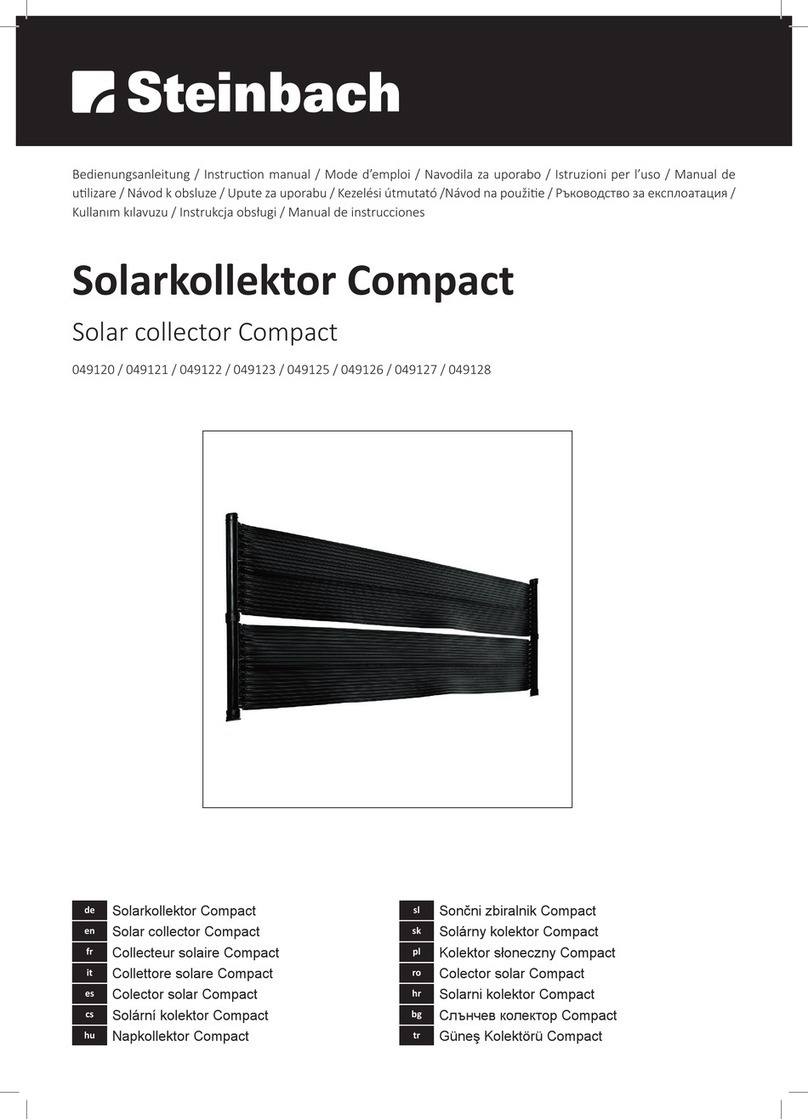
Steinbach
Steinbach 049120 instruction manual
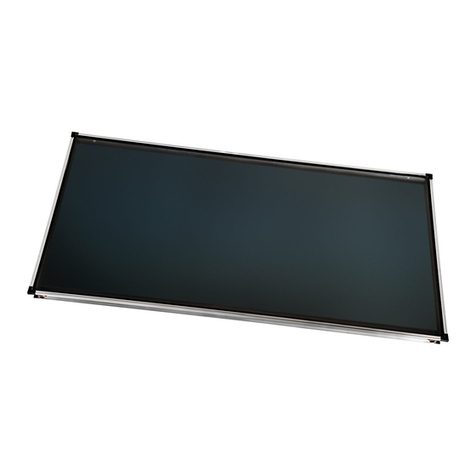
KAIROS
KAIROS CF 2.0-1 manual

Hanwha Solar
Hanwha Solar HSL60P6-PB-1-xxx Series installation guide
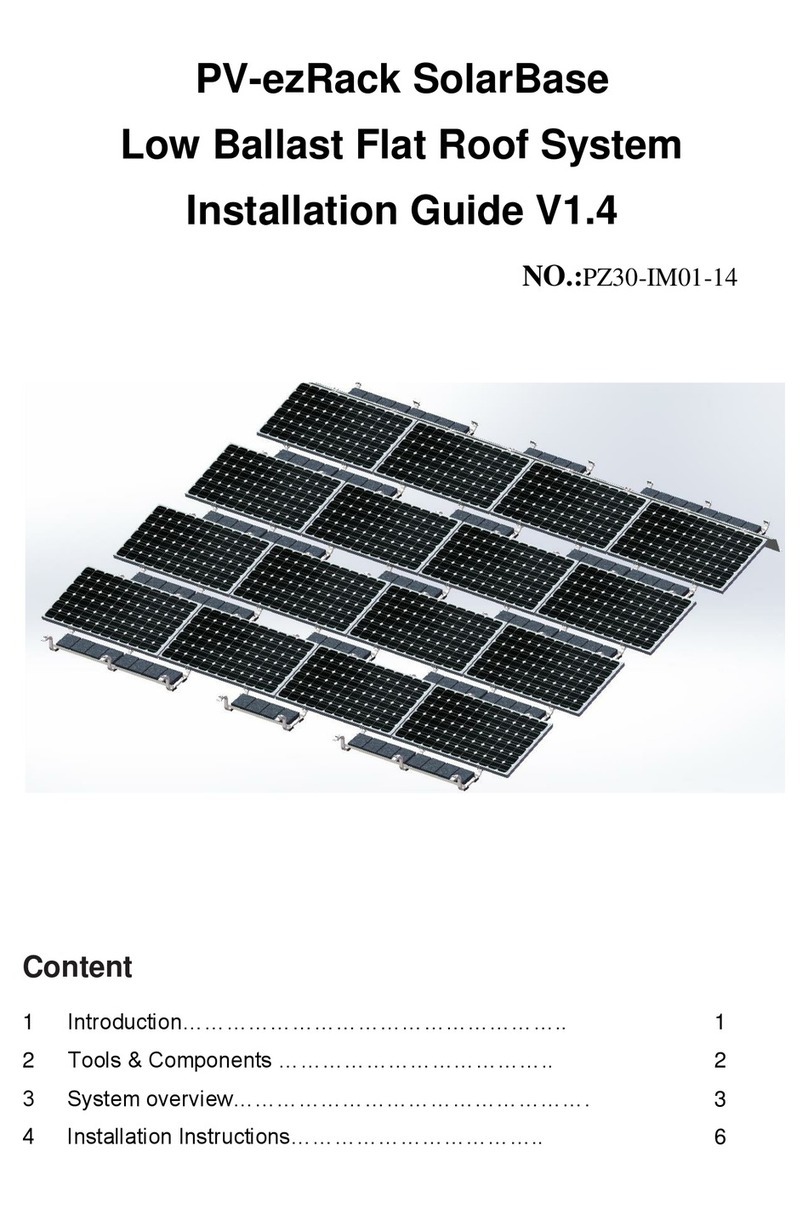
Clenergy
Clenergy PV-ezRack SolarBase installation guide

Solar Technology International
Solar Technology International SolarMate Arena 2 Light user manual

Potterton
Potterton Solar installation guide
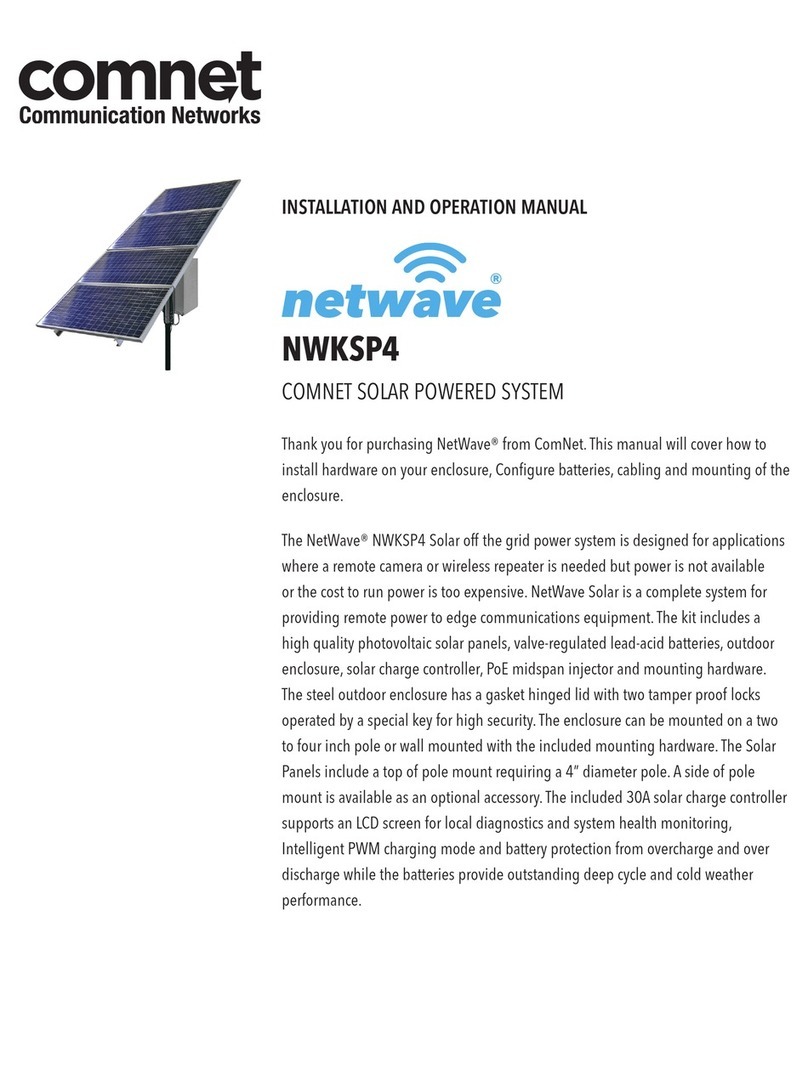
Comnet
Comnet netwave NWKSP4 Installation and operation manual

Anker
Anker PowerSolar 3-Port 24W user manual

Viessmann
Viessmann VITOSOL 200-F installation instructions

ECO-WORTHY
ECO-WORTHY ECO-120W user manual
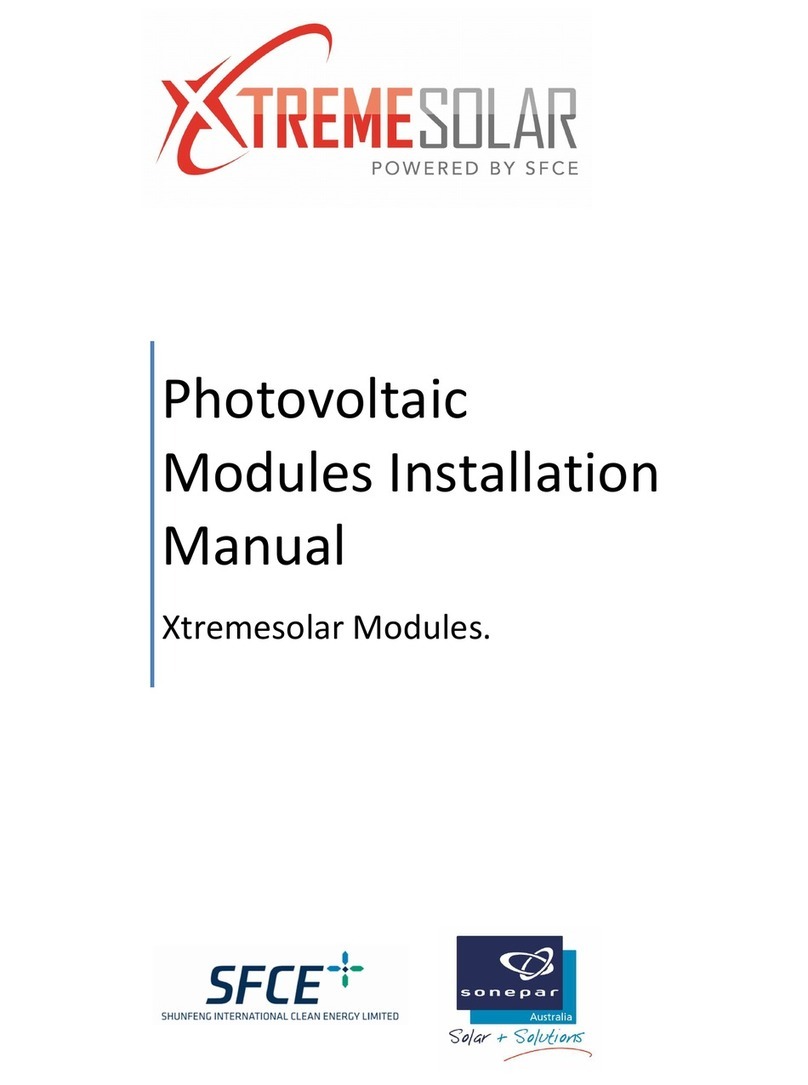
SFC Energy
SFC Energy XTREMESOLAR XTR-S290P Series installation manual
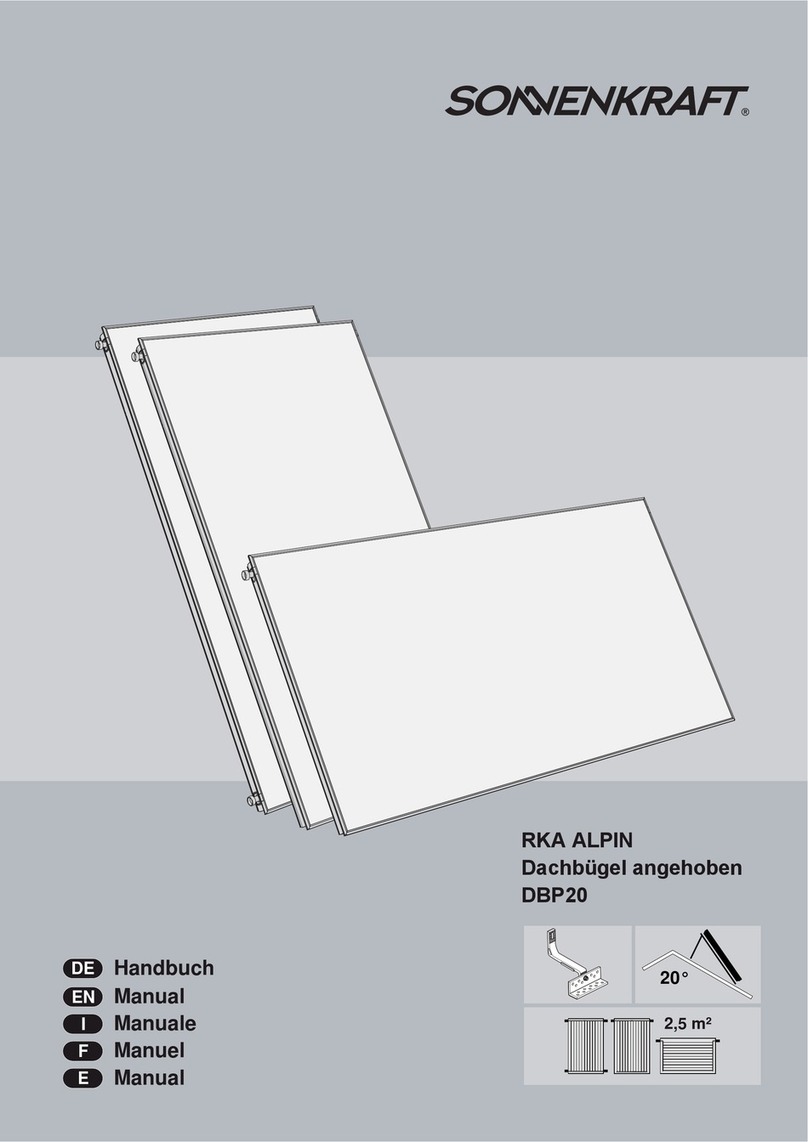
Sonnenkraft
Sonnenkraft DBP20 manual
